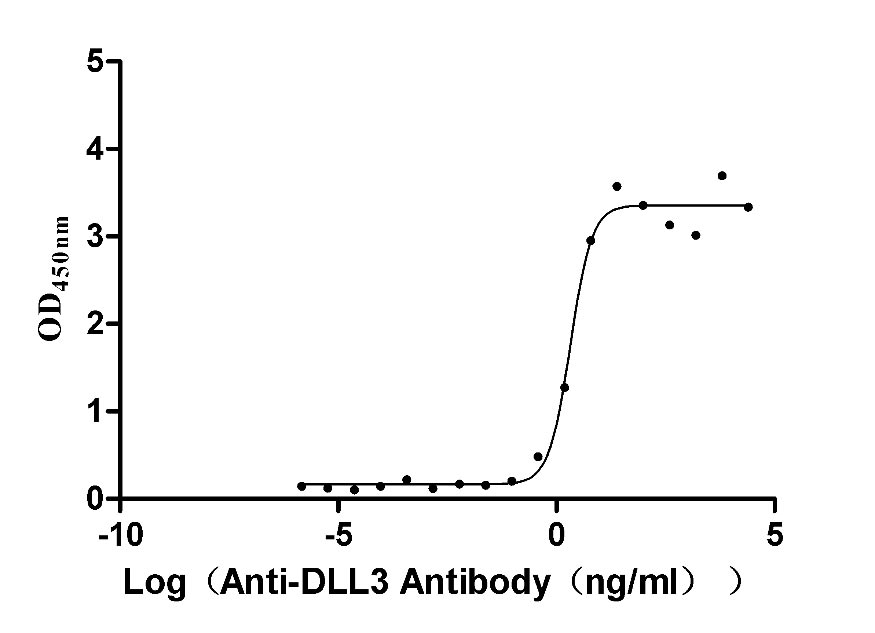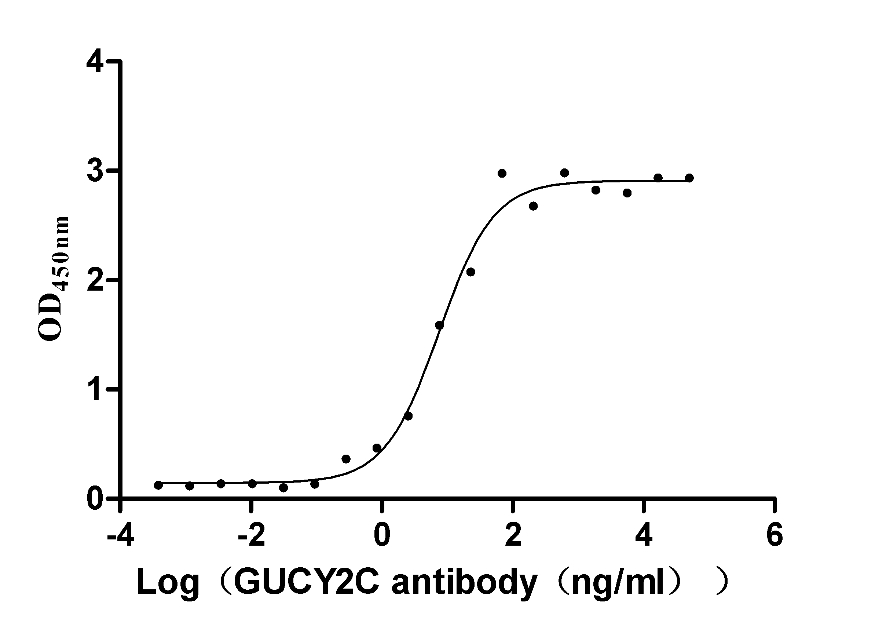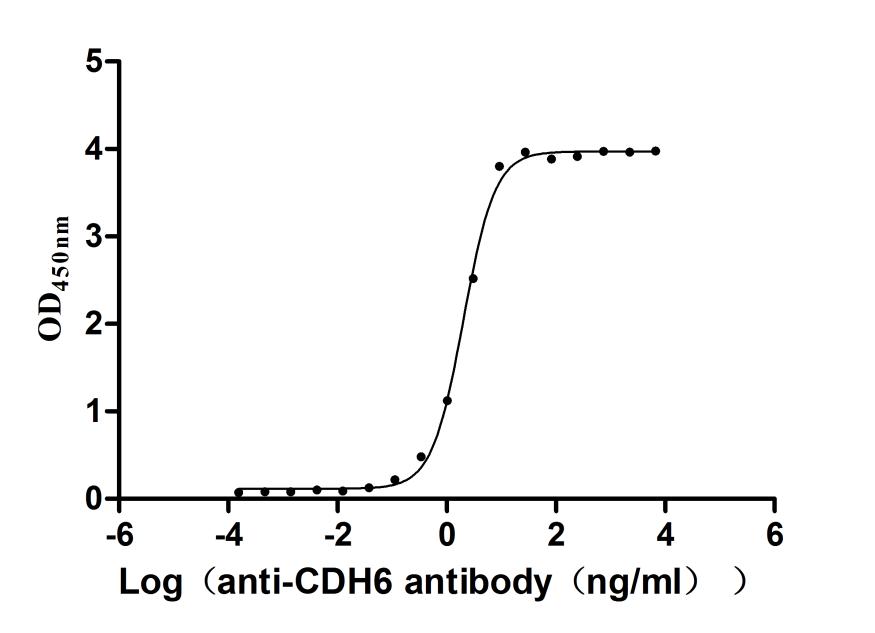Recombinant Mouse Tumor necrosis factor receptor superfamily member 1A (Tnfrsf1a), partial
-
中文名称:小鼠Tnfrsf1a重组蛋白
-
货号:CSB-YP023977MO1
-
规格:
-
来源:Yeast
-
其他:
-
中文名称:小鼠Tnfrsf1a重组蛋白
-
货号:CSB-EP023977MO1
-
规格:
-
来源:E.coli
-
其他:
-
中文名称:小鼠Tnfrsf1a重组蛋白
-
货号:CSB-EP023977MO1-B
-
规格:
-
来源:E.coli
-
共轭:Avi-tag Biotinylated
E. coli biotin ligase (BirA) is highly specific in covalently attaching biotin to the 15 amino acid AviTag peptide. This recombinant protein was biotinylated in vivo by AviTag-BirA technology, which method is BriA catalyzes amide linkage between the biotin and the specific lysine of the AviTag.
-
其他:
-
中文名称:小鼠Tnfrsf1a重组蛋白
-
货号:CSB-BP023977MO1
-
规格:
-
来源:Baculovirus
-
其他:
-
中文名称:小鼠Tnfrsf1a重组蛋白
-
货号:CSB-MP023977MO1
-
规格:
-
来源:Mammalian cell
-
其他:
产品详情
-
纯度:>85% (SDS-PAGE)
-
基因名:
-
Uniprot No.:
-
别名:Tnfrsf1a; Tnfr-1; Tnfr1; Tumor necrosis factor receptor superfamily member 1A; Tumor necrosis factor receptor 1; TNF-R1; Tumor necrosis factor receptor type I; TNF-RI; TNFR-I; p55; p60; CD antigen CD120a
-
种属:Mus musculus (Mouse)
-
蛋白长度:Partial
-
蛋白标签:Tag type will be determined during the manufacturing process.
The tag type will be determined during production process. If you have specified tag type, please tell us and we will develop the specified tag preferentially. -
产品提供形式:Lyophilized powder
Note: We will preferentially ship the format that we have in stock, however, if you have any special requirement for the format, please remark your requirement when placing the order, we will prepare according to your demand. -
复溶:We recommend that this vial be briefly centrifuged prior to opening to bring the contents to the bottom. Please reconstitute protein in deionized sterile water to a concentration of 0.1-1.0 mg/mL.We recommend to add 5-50% of glycerol (final concentration) and aliquot for long-term storage at -20℃/-80℃. Our default final concentration of glycerol is 50%. Customers could use it as reference.
-
储存条件:Store at -20°C/-80°C upon receipt, aliquoting is necessary for mutiple use. Avoid repeated freeze-thaw cycles.
-
保质期:The shelf life is related to many factors, storage state, buffer ingredients, storage temperature and the stability of the protein itself.
Generally, the shelf life of liquid form is 6 months at -20°C/-80°C. The shelf life of lyophilized form is 12 months at -20°C/-80°C. -
货期:Delivery time may differ from different purchasing way or location, please kindly consult your local distributors for specific delivery time.Note: All of our proteins are default shipped with normal blue ice packs, if you request to ship with dry ice, please communicate with us in advance and extra fees will be charged.
-
注意事项:Repeated freezing and thawing is not recommended. Store working aliquots at 4°C for up to one week.
-
Datasheet :Please contact us to get it.
相关产品
靶点详情
-
功能:Receptor for TNFSF2/TNF-alpha and homotrimeric TNFSF1/lymphotoxin-alpha. The adapter molecule FADD recruits caspase-8 to the activated receptor. The resulting death-inducing signaling complex (DISC) performs caspase-8 proteolytic activation which initiates the subsequent cascade of caspases (aspartate-specific cysteine proteases) mediating apoptosis.
-
基因功能参考文献:
- This study demonstrated that the TNFR1, but not TNFR2, is Required for Both Histaminergic and Non-histaminergic Itch in Mice. PMID: 28365861
- p55TNFR shedding has a prominent role in Th1 mediated protection against chronic and latent tuberculosis infection PMID: 27995986
- p55TNFR-IKK2-Ripk3 signalling orchestrates arthritogenic and death responses in synovial fibroblasts PMID: 29434332
- his study shows that CCR-2/TLR-2 triggered signaling in murine peritoneal macrophages intensifies bacterial (Staphylococcus aureus) killing by reactive oxygen species through TNF-R1 PMID: 28736159
- Results provide experimental data on the existence of a TNFRp55-mediated anti-inflammatory circuit in dendritic cells which might contribute to the protection against reactive arthritis during the resolution of Yersinia entercolitica infection. PMID: 29494692
- TNFR1 contributes to ethanol-induced hypertension and oxidative stress in the vasculature. PMID: 28797835
- TNFR2 is important for the proliferative expansion of pathogenic Teff cells PMID: 27601345
- NEMO deficiency hampered activation of IKK complex in osteoclast precursors, causing arrest of osteoclastogenesis and apoptosis. Interestingly, inhibiting apoptosis by genetic ablation of TNFr1 significantly increased cell survival, but failed to rescue osteoclastogenesis or reverse osteopetrosis. PMID: 27435916
- Data indicate that IL-1RI and TNF-1R contribute to regulation of stress-induced, negatively reinforced drinking perhaps through overlapping signaling events downstream of these receptors, while leaving rewarding properties of alcohol largely unaffected. PMID: 27273552
- Myeloid-derived suppressor cells from tumor necrosis factor receptor (TNFR) 2(-/-) mice, but not from TNFR1(-/-) mice, failed to promote B-cell responses. PMID: 27133471
- TNFR2 is required for inflammation-inducible M cells. PMID: 27932454
- These findings indicate that TNFR1 is structurally positioned to modulate postsynaptic signaling in the PVN, suggesting a mechanism whereby TNFR1 activation contributes to cardiovascular and other autonomic functions. PMID: 28385632
- Increased TNFR1 expression and signaling in injured peripheral nerves of mice with reduced BACE1 activity PMID: 27080468
- Genetic deletion of TNFR1 completely blocks TNF-alpha-induced inflammation and reduces allergen-induced inflammation. Preserved electro-olfactogram responses suggest a TNFR1-dependent mechanism of TNF-alpha-induced olfactory neuron dysfunction. PMID: 27671548
- This work uncovers a dichotomy of function for TNFR2 in myeloid cells, with microglial TNFR2 providing protective signals to contain disease and monocyte/macrophagic TNFR2 driving immune activation and experimental autoimmune encephalomyelitis initiation. PMID: 28052249
- The deficiency of TNFRp55 promoted the development of endometriosis. PMID: 28676525
- TNFalpha enhanced murine NK cell IFNgamma production via TNFR2 in vitro PMID: 27560480
- TNFR2 sensitizes macrophages for endogenous TNF-induced TNFR1-mediated necroptosis PMID: 27899821
- this study shows that epithelial TNFR1 signaling promotes mucosal repair in inflammatory bowel disease PMID: 28747340
- HACE1 controls TNF-elicited cell fate decisions and exerts tumor suppressor and anti-inflammatory activities via a TNFR1-RIP3 kinase-necroptosis pathway. PMID: 27160902
- TNFR2 activation exerted beneficial effects on OPA1 expression in an aortic constriction model. PMID: 28637784
- Following activation by transmembrane TNF, TNFR2 initiates pathways that drive oligodendrocytes into a reparative mode contributing to remyelination following disease PMID: 27147664
- The apoptotic signals through TNFR1 appear critical for the pathogenesis of pulmonary emphysema. PMID: 27555760
- TNFR1 signaling in myeloid-derived cells is a critical mediator of both the detrimental and the protective functions of TNF in T cell-induced hepatitis and bacterial infection, respectively. PMID: 26991125
- Suggest an atheroprotective role of ADAM17, which might be mediated by cleaving membrane-bound TNFalpha and TNFR2, thereby preventing overactivation of endogenous TNFR2 signaling in cells of the vasculature. PMID: 28062509
- this study shows that Tnfr1 knock-out display reduced chemotaxis of myeloid-derived suppressor cells to tumor, and mice reject transplanted tumor PMID: 28092866
- tumor necrosis factor-alpha, through its receptor tumor necrosis factor receptor -1, promoted cell proliferation and cell survival in prostate by activation of the AKT/mTOR and NFKB pathway, which stimulated prostate carcinogenesis PMID: 27018768
- Report chronic inflammatory multiorgan hepatobiliary pancreatitis, along with fibrosis and calculi formation induced by oral dibutyltin administration in TNFR1/R2 deficient mice. PMID: 27275091
- Knockdown of TNFR1 not only inhibited the JNK pathway but also reduced Toll-like receptor 2 protein and RANKL levels in S. aureus-infected cells. PMID: 26846887
- we have demonstrated that PGRN-mediated inhibition of chemokine expression largely depends on TNFR1. PMID: 26892362
- The results of comparative analysis of interaction between the protein cytotoxic complex Tag 7-Hsp70 and the Tag 7 component of this complex with TNFR1 receptor in solution and in tumor cells are presented. PMID: 27021371
- These results show that in the absence of TNFRp55, Leishmania (Leishmania) amazonensis-infected knockout mice fail to resolve lesions, whereas wild-type mice completely heal. PMID: 24856420
- These findings implicate TNF-receptor signaling cascades in the regulation of homeostatic plasticity of denervated networks and suggest an important role for TNFalpha-signaling in the course of neurological diseases accompanied by deafferentation. PMID: 26246237
- DMS5540 is a potent mouse TNFR1 antagonist with in vivo pharmacokinetic PMID: 26352810
- TNF receptor 1 (TnfR1) signaling is believed to be a major mediator of the cytotoxicity of Tnf-a through activation of caspases. PMID: 26189092
- The s found that miR-511 inhibits endotoxemia and experimental hepatitis and that this miR is strongly induced by glucocorticoids and is a true TNFR1 modulator and thus an anti-inflammatory miR. PMID: 25995337
- Data show that ileal sections were costained for glucagon-like peptide-1 (GLP-1) and tumor necrosis factor receptor TNFR1. PMID: 26270730
- quercetin reduces cell survival and promotes death receptor-mediated apoptosis via differential localization of the TNFR1 level in ascite cells PMID: 26076811
- Following memory deficit induced by sepsis, memory is preserved in the absence of TNFR1. PMID: 25148914
- we identified P55-induced goblet and Paneth cell dysfunction as a crucial mechanism for TNF-induced systemic and lethal inflammation. PMID: 25425265
- In IL-32alpha-Tg mice, azoxymethane (AOM)-induced colon cancer incidence was decreased, whereas expression of TNFR1 and TNFR1-mediated apoptosis was increased. PMID: 25909160
- pan antagonist of AnxA1 receptors exacerbated the colitis outcome in TNFR1-/- mice, supporting the pivotal role of AnxA1 in the early recovery PMID: 26386311
- Data show that the in utero death of NF-NF-kappaB essential modulator (NEMO) and cylindromatosis protein double mutant mice is mediated by TNF receptor 1 (TNFR1) signaling and can be rescued by TNFR1 deficiency. PMID: 26224629
- TNFR2 promotes generation of Foxp3+ Tregs. TNFR2 inhibits Th17 differentiation by promoting Il2 expression. And under Th17-polarizing conditions, selective blockade of CD4(+) T cell-intrinsic TNFR2 appears sufficient to promote Th17 differentiation. PMID: 26268655
- TNFR1 (and JNK signaling) is the shared pathway leading to neuroinflammation and neurovascular damage. PMID: 25540015
- PGRN protects against colitis progression in mice in an IL-10 and TNFR2 dependent manner. PMID: 25387791
- results suggest that the ability of S. aureus to activate TNFR1 and Ca(2+)/calpain signaling contribute to T cell activation and excessive inflammation in the setting of acute pneumonia. PMID: 24736233
- necroptosis induced by various ER stressors in L929 cells is dependent on tumor necrosis factor receptor 1. PMID: 25569104
- Shedding of the tumor necrosis factor (TNF) receptor from the surface of hepatocytes during sepsis limits inflammation through cGMP signaling. PMID: 25628461
- TNFR1- and IFNAR1-deficient mice showed partial protection toward Aldara-induced inflammation compared with control groups. Double knockout mice lacking both receptors showed superior protection to Aldara in comparison with the single knockout mice. PMID: 25911755
显示更多
收起更多
-
亚细胞定位:Cell membrane; Single-pass type I membrane protein. Golgi apparatus membrane; Single-pass type I membrane protein.
-
数据库链接:
KEGG: mmu:21937
STRING: 10090.ENSMUSP00000032491
UniGene: Mm.1258
Most popular with customers
-
Recombinant Macaca fascicularis Delta-like protein 3 (DLL3), partial (Active)
Express system: Mammalian cell
Species: Macaca fascicularis (Crab-eating macaque) (Cynomolgus monkey)
-
Recombinant Human Heat-stable enterotoxin receptor (GUCY2C), partial (Active)
Express system: Mammalian cell
Species: Homo sapiens (Human)
-
Recombinant Macaca mulatta Semaphorin-4D isoform 1 (SEMA4D), partial (Active)
Express system: Mammalian cell
Species: Macaca mulatta (Rhesus macaque)
-
Recombinant Human Cannabinoid receptor 1 (CNR1)-VLPs (Active)
Express system: Mammalian cell
Species: Homo sapiens (Human)
-
Recombinant Human Serine/threonine-protein kinase receptor R3 (ACVRL1), partial (Active)
Express system: Baculovirus
Species: Homo sapiens (Human)
-
Recombinant Macaca fascicularis CUB domain containing protein 1 (CDCP1), partial (Active)
Express system: Mammalian cell
Species: Macaca fascicularis (Crab-eating macaque) (Cynomolgus monkey)
-
Recombinant Human Transmembrane 4 L6 family member 1(TM4SF1)-VLPs (Active)
Express system: Mammalian cell
Species: Homo sapiens (Human)
-
Recombinant Mouse Cadherin-6(Cdh6),partial (Active)
Express system: Mammalian cell
Species: Mus musculus (Mouse)




















